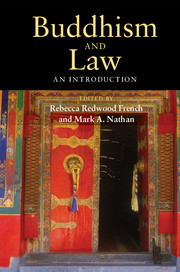Book contents
- Frontmatter
- Dedication
- Contents
- Maps and Illustrations
- Contributors
- Preface
- Abbreviations
- Introducing Buddhism and Law
- Part I The Roots of Buddhism and Law in India
- Part II Buddhism and Law in South and Southeast Asia
- Part III Buddhism and Law in East Asia
- 11 Buddhism and Law in China
- 12 The Ownership and Theft of Monastic Land in Ming China
- 13 Buddhism and Law in China
- 14 Buddhism and Law in Korean History
- 15 Buddhism and Law in Japan
- 16 Relic Theft in Medieval Japan
- Part IV Buddhism and Law in North Asia and the Himalayan Region
- A Selection of Readings
- Index
- References
16 - Relic Theft in Medieval Japan
Published online by Cambridge University Press: 05 August 2014
- Frontmatter
- Dedication
- Contents
- Maps and Illustrations
- Contributors
- Preface
- Abbreviations
- Introducing Buddhism and Law
- Part I The Roots of Buddhism and Law in India
- Part II Buddhism and Law in South and Southeast Asia
- Part III Buddhism and Law in East Asia
- 11 Buddhism and Law in China
- 12 The Ownership and Theft of Monastic Land in Ming China
- 13 Buddhism and Law in China
- 14 Buddhism and Law in Korean History
- 15 Buddhism and Law in Japan
- 16 Relic Theft in Medieval Japan
- Part IV Buddhism and Law in North Asia and the Himalayan Region
- A Selection of Readings
- Index
- References
Summary
Throughout its history, Buddhism had to adapt to the various legal, political, and social environments it encountered, while developing its own monastic legal system, the Vinaya. Among the four pārājika rules leading to exclusion from the monastic community, the rule about theft comes second, just after the one about illicit sex and before those about murder and boasting of spiritual powers. Indeed, it seems to have generated as many legalistic commentaries as the rule about illicit sex. Yet, unlike illicit sex and the taking of life (the latter mostly by meat-eating), theft never became a narrative topos. In both China and Japan, stories abound about meat-eating, drinking, and fornicating monks, whereas stealing among monks is not often discussed, and much less justified. Only very few texts consider it as a skillful means (upāya). Most references to theft contain dire warnings against stealing the saṅgha’s (or, more precisely, the Buddha’s) property. Outside the clerical community, however, the Buddhist clergy did not try to legislate on moral and legal issues and to sanction laymen’s offenses, as did, for instance, the Church in medieval Europe.
As in the case of other pārājika offenses, early Buddhist condemnations of theft reflect an attempt to align the Buddhist community with the larger society and its legal system. However, they also sometimes aim – in the case of medieval Japan, for instance – to protect the property of the monasteries. Since the saṅgha was often identified with the Buddha, any theft of monastic – therefore sacred – property became a sacrilege against the Buddha himself.
- Type
- Chapter
- Information
- Buddhism and LawAn Introduction, pp. 288 - 302Publisher: Cambridge University PressPrint publication year: 2014



